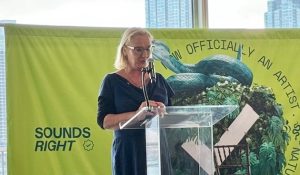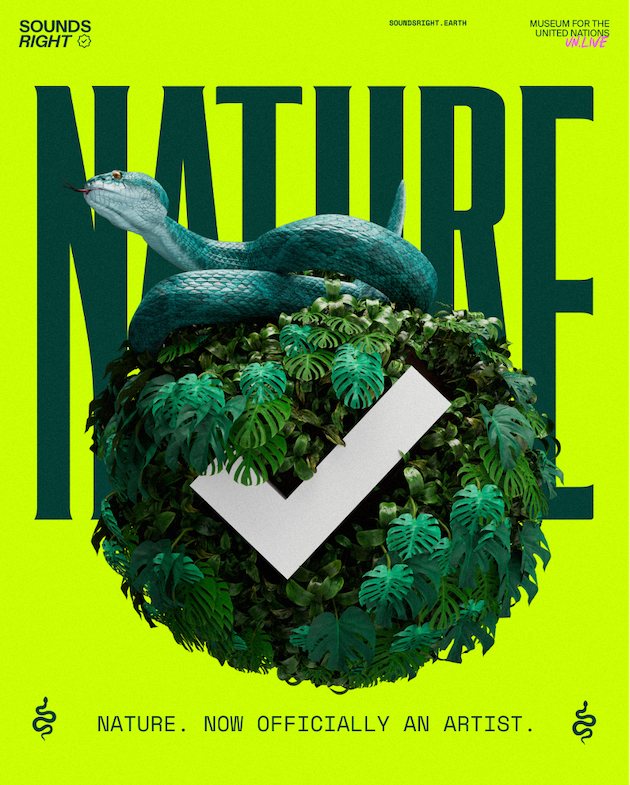
UN Live’s CEO Katja Iversen at the launch of ‘Sounds Right’. Credit: Naureen Hossain/IPS
By Naureen Hossain
NEW YORK, Apr 22 2024 – UN Live’s CEO, Katja Iversen, says the way to engage people in the environment is through popular culture—film, music, gaming, sports, food, and fashion. She is excited about the Sounds Right project, which puts the sounds of nature—bird songs, waves, wind, and rainfall—at the center of a campaign to support those involved in climate action.
In an exclusive interview with IPS, Iversen shares the motivation behind this innovative project.
The Sounds Right initiative was officially launched on April 18. It established NATURE as an official artist, eligible to earn royalties. Music fans were invited to support nature conservation by listening to NATURE’s recordings or tracks with musicians. This initiative was developed and delivered by the Museum for the United Nations (UN Live) and a broad range of partners in the music and environmental sectors.
IPS: How was the Sounds Right initiative conceived? What is the significance of recognizing NATURE in the same way that we recognize and reward musical artists through royalties?
Katja Iversen: The “Sounds Right” initiative was conceived as a global music movement to prompt conversations about the value of nature, raise innovative financing for conservation, and inspire millions of fans to take action.
The original idea came out of a project called VozTerra in Colombia, which the Museum for the United Nations—UN Live helped initiate. The initiative, as it looks today, has been developed by UN Live in close partnership with musicians, creatives, and nature sound recordists, as well as environmental, campaigning, and global advocacy organizations and VozTerra.
The significance of the initiative is that it treats NATURE as the artist she truly is and nature’s sounds—such as bird songs, waves, wind, and rainfall—as artistic works deserving of royalty payment. It leverages the power of music to connect fans with nature by having artists feature natural sounds in new and existing tracks.
It is going to be really big. To test things out, NATURE was discretely established as an official artist two weeks ago on various streaming platforms, including with some pure nature sounds. As of today, on Spotify alone, NATURE is in the top 10 percent of artists, with over 500k monthly listeners and almost 5 million streams—even before the initiative is officially launched and a playlist with artists featuring nature tracks goes online.
IPS: How was the Museum for the UN—UN Live able to bring together artists, music executives, and environmental groups for this initiative?
Iversen: The Museum for the UN—UN Live, together with EarthPercent, has organized the collaboration between artists, music executives, and environmental groups by leveraging our unique position at the intersection of culture, sustainable development, and diplomacy. We, at UN Live, have a track record of engaging very diverse communities in innovative cultural programmes, and we were able to draw on our extensive networks and entrepreneurial skills to bring together a broad variety of groups around a great idea.
It is a truly unique coalition of partners, including EarthPercent, AKQA, Hempel Foundation, Dalberg, Count Us In, VozTerra, Axum, Music Declares Emergency, Earthrise, Eleutheria Group, The Listening Planet, Biophonica, Community Arts Network, Limbo Music, LD Communications, No. 29, and Rare. We developed the initiative in consultation with the UN Department of Global Communications, and we’ve also joined forces with The Nature Conservancy, Wildlife Conservation Society, APCO, Riky Rick Foundation, AWorld x ActNow and others to reach the many millions of people.

Sounds Right poster.
IPS: How do you foresee artists and environmental groups from developing countries connecting with this initiative now and in the future?
Iversen: We are very serious about this not being a Global North undertaking. Recognizing that the global majority is often at the forefront of experiencing the impacts of loss of biodiversity and climate change while living in some of the world’s most important ecosystems, this is also where the solutions and the most important voices are found—both the voices of humans and nature. Of the first group of 16 artists on the first Feat Nature playlist, there are musicians from Venezuela, Colombia, Kenya, India, and Indonesia. And on future compilations, more will come.
Just imagine that as NATURE the artist grows and grows, more and more musicians will want to collaborate and feature nature in their music. We are looking forward to working with musicians from across the globe and will, in time, potentially also develop special releases focused on certain geographies, issues, or groups.
The funds raised will be distributed under the guidance of the Sounds Right Expert Advisory Panel, a group of world-leading biologists, environmental activists, representatives of Indigenous Peoples, and experts in conservation funding. The majority of the experts are from the global majority.
IPS: How does ‘Sounds Right’ go toward serving the SDGs?
Iversen: Well, we are the Museum for the United Nations, and we are here to rally the world around the work, values, and goals of the United Nations, so naturally Sounds Right is also aligned with the SDGs.
More particularly, it aligns with the goals related to life on land (SDG 15) and underwater (SDG 14) by funding conservation projects through royalties collected from nature-based recordings. Additionally, by raising awareness and fostering an appreciation for the environment through music, the initiative supports SDG 13 (climate action) and SDG 17 (partnerships for the goals) and also justice.
Importantly, Sounds Right is an example of the power of popular culture and exemplifies how creative industries and popular culture platforms can contribute to achieving the SDGs, including by merging artistic expression with environmental activism.
IPS: How does the Museum for the UN—UN Live leverage culture to promote the SDGs?
Iversen: If we could solve the world’s problems and achieve the SDGs with data, facts, figures, and reports alone, it would have been done. What we also need is to work with culture, norms, opinions, feelings, and hearts. We know that popular culture—film, music, gaming, sports, food, fashion—affects people’s opinions, norms, and actions. So if we really want to change and if we want to reach the many, we go to where the many are. It’s in their earbuds, it’s on their phones, it’s on their screens, and it’s on their sports fields. That’s where you hit both the head and the heart.
That’s what we need, in addition to the facts and the figures. U.N. Live worked with popular culture, unleashed the power of popular culture to reach many people—millions and billions of people—because they use popular culture. So we have to go where the people are with the messages they can understand and the actions they want to take.
IPS UN Bureau Report